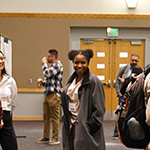NEWS
2015 STEMAP Setting Records

By Chelsea Chee
Last fall, the STEM Advancement Program (STEMAP) Coordinators (including myself) began recruiting for this summer’s group of undergraduate summer researchers. We traveled 2,463 miles and 40 hours to visit 14 campuses to share information about our 2015 STEMAP program; see the map below. All that effort paid off!

We received a record 52 STEMAP applications from 16 campuses, the most applications from the most campuses to date. 67% of applicants were underrepresented minority, see the chart below for further breakdown.

Students submitted applications from the following 16 campuses:
- Central New Mexico Community College
- Santa Fe Community College
- Navajo Technical University
- Eastern New Mexico University
- University of New Mexico-Valencia
- New Mexico State University-Alamogordo
- New Mexico Highlands University
- New Mexico State University-Carlsbad
- New Mexico State University-Grants
- Western New Mexico University
- Clovis Community College
- Dine College
- Eastern New Mexico University-Ruidoso
- Luna Community College
- Mesalands Community College
- New Mexico State University-Doña Ana

Student applicants were given nine research areas to choose from, including:
- Algae for Energy - Algal Cultivation and Extraction Research
- Encapsulating Living Cells for Biofuel and Bioproducts
- Visualizing Function in Live Cells for Bioenergy Applications
- Imaging Geothermal Systems using Magentotelluric Methods
- Using Geochemical Tracers in Geothermal Systems
- Osmotic Power Development – Acquiring Energy from Waste Water
- New Mexico’s Energy/Water Future - Attitudes and Preferences Towards Energy Production
- Photons to Fuels and Feedstocks: Solar Energy in New Mexico
- Assessing Uranium Contamination on the Navajo and Laguna Reservations
We are now working to select students for each research team. The 2015 STEM Advancement Program will began June 1, 2015 and end July 31, 2015 with research presentations on July 30. We look forward to welcoming the STEMAP 2015 Cohort to NM EPSCoR and will share information about their activities and research presentations in future postings.

